Monetary Policy Assignment Sample
VerifiedAdded on 2021/06/17
|16
|3842
|3
AI Summary
Contribute Materials
Your contribution can guide someone’s learning journey. Share your
documents today.
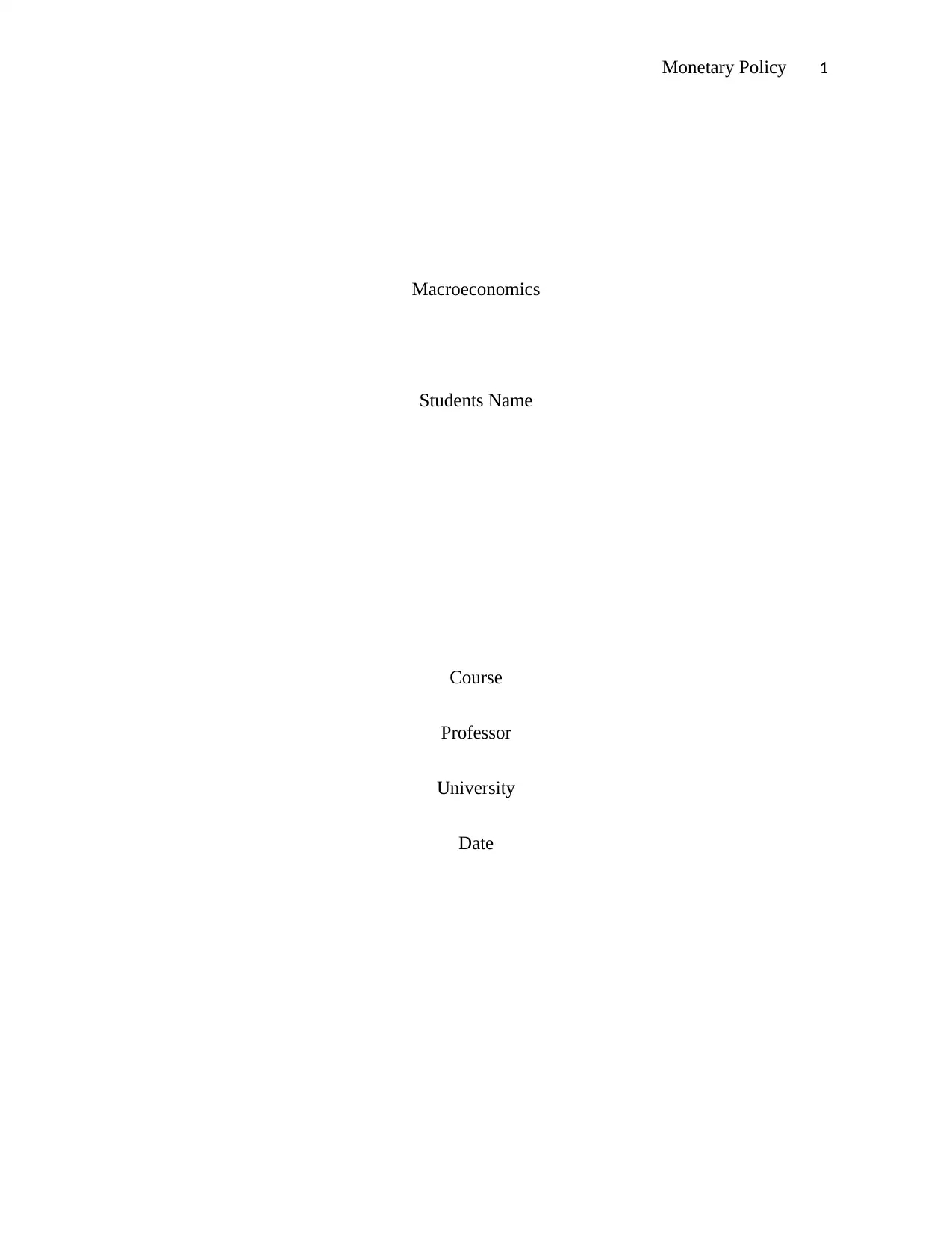
Monetary Policy 1
Macroeconomics
Students Name
Course
Professor
University
Date
Macroeconomics
Students Name
Course
Professor
University
Date
Secure Best Marks with AI Grader
Need help grading? Try our AI Grader for instant feedback on your assignments.
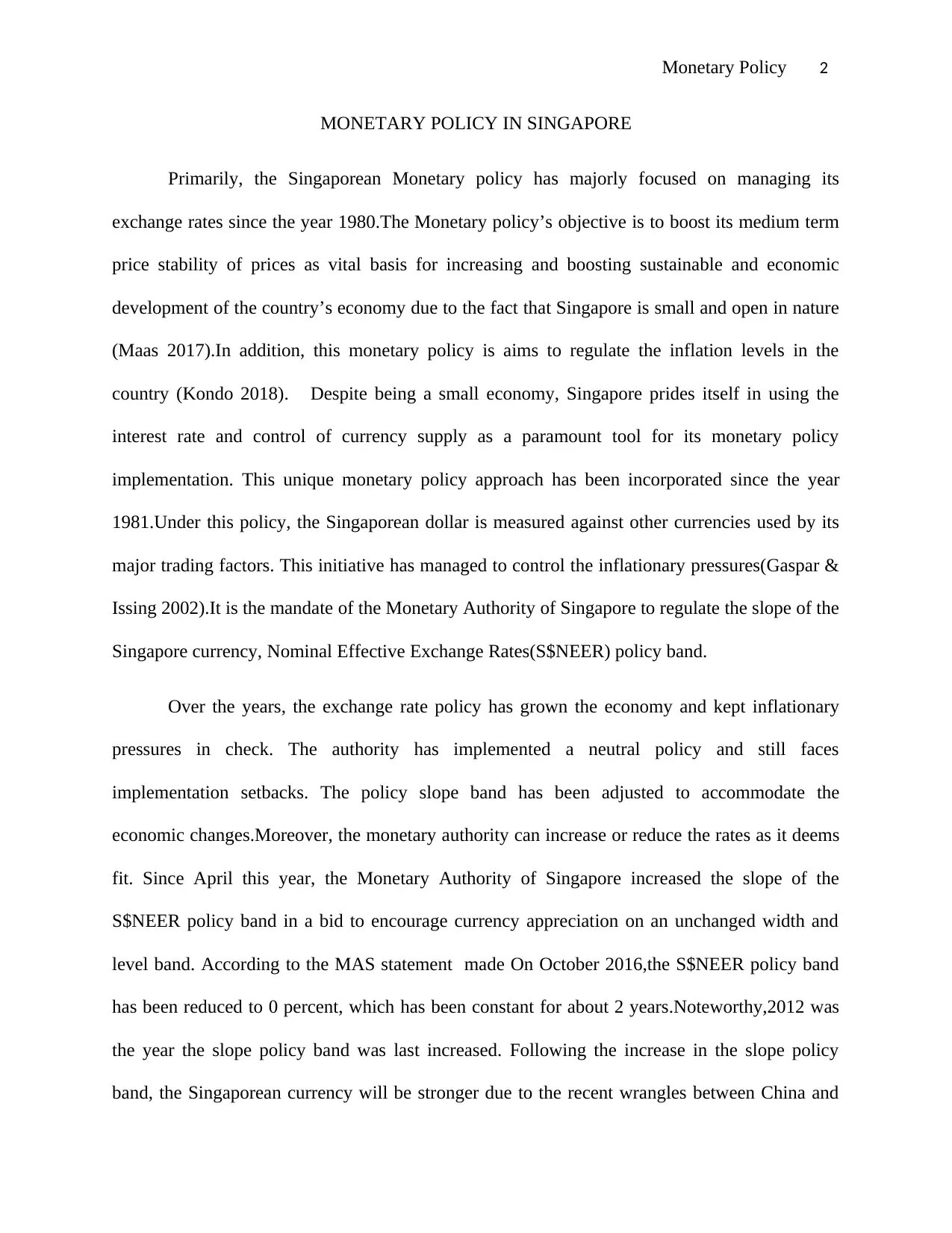
Monetary Policy 2
MONETARY POLICY IN SINGAPORE
Primarily, the Singaporean Monetary policy has majorly focused on managing its
exchange rates since the year 1980.The Monetary policy’s objective is to boost its medium term
price stability of prices as vital basis for increasing and boosting sustainable and economic
development of the country’s economy due to the fact that Singapore is small and open in nature
(Maas 2017).In addition, this monetary policy is aims to regulate the inflation levels in the
country (Kondo 2018). Despite being a small economy, Singapore prides itself in using the
interest rate and control of currency supply as a paramount tool for its monetary policy
implementation. This unique monetary policy approach has been incorporated since the year
1981.Under this policy, the Singaporean dollar is measured against other currencies used by its
major trading factors. This initiative has managed to control the inflationary pressures(Gaspar &
Issing 2002).It is the mandate of the Monetary Authority of Singapore to regulate the slope of the
Singapore currency, Nominal Effective Exchange Rates(S$NEER) policy band.
Over the years, the exchange rate policy has grown the economy and kept inflationary
pressures in check. The authority has implemented a neutral policy and still faces
implementation setbacks. The policy slope band has been adjusted to accommodate the
economic changes.Moreover, the monetary authority can increase or reduce the rates as it deems
fit. Since April this year, the Monetary Authority of Singapore increased the slope of the
S$NEER policy band in a bid to encourage currency appreciation on an unchanged width and
level band. According to the MAS statement made On October 2016,the S$NEER policy band
has been reduced to 0 percent, which has been constant for about 2 years.Noteworthy,2012 was
the year the slope policy band was last increased. Following the increase in the slope policy
band, the Singaporean currency will be stronger due to the recent wrangles between China and
MONETARY POLICY IN SINGAPORE
Primarily, the Singaporean Monetary policy has majorly focused on managing its
exchange rates since the year 1980.The Monetary policy’s objective is to boost its medium term
price stability of prices as vital basis for increasing and boosting sustainable and economic
development of the country’s economy due to the fact that Singapore is small and open in nature
(Maas 2017).In addition, this monetary policy is aims to regulate the inflation levels in the
country (Kondo 2018). Despite being a small economy, Singapore prides itself in using the
interest rate and control of currency supply as a paramount tool for its monetary policy
implementation. This unique monetary policy approach has been incorporated since the year
1981.Under this policy, the Singaporean dollar is measured against other currencies used by its
major trading factors. This initiative has managed to control the inflationary pressures(Gaspar &
Issing 2002).It is the mandate of the Monetary Authority of Singapore to regulate the slope of the
Singapore currency, Nominal Effective Exchange Rates(S$NEER) policy band.
Over the years, the exchange rate policy has grown the economy and kept inflationary
pressures in check. The authority has implemented a neutral policy and still faces
implementation setbacks. The policy slope band has been adjusted to accommodate the
economic changes.Moreover, the monetary authority can increase or reduce the rates as it deems
fit. Since April this year, the Monetary Authority of Singapore increased the slope of the
S$NEER policy band in a bid to encourage currency appreciation on an unchanged width and
level band. According to the MAS statement made On October 2016,the S$NEER policy band
has been reduced to 0 percent, which has been constant for about 2 years.Noteworthy,2012 was
the year the slope policy band was last increased. Following the increase in the slope policy
band, the Singaporean currency will be stronger due to the recent wrangles between China and
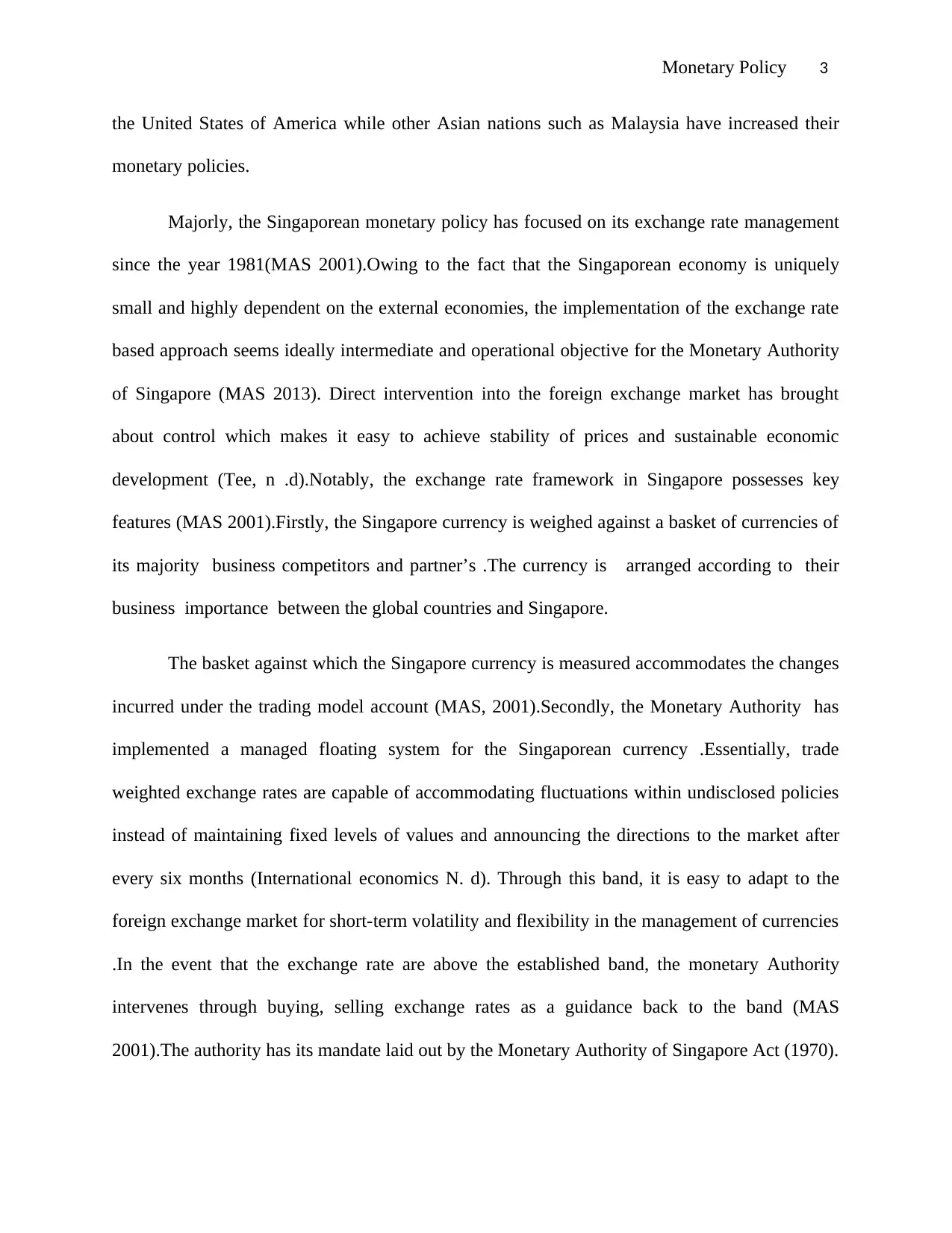
Monetary Policy 3
the United States of America while other Asian nations such as Malaysia have increased their
monetary policies.
Majorly, the Singaporean monetary policy has focused on its exchange rate management
since the year 1981(MAS 2001).Owing to the fact that the Singaporean economy is uniquely
small and highly dependent on the external economies, the implementation of the exchange rate
based approach seems ideally intermediate and operational objective for the Monetary Authority
of Singapore (MAS 2013). Direct intervention into the foreign exchange market has brought
about control which makes it easy to achieve stability of prices and sustainable economic
development (Tee, n .d).Notably, the exchange rate framework in Singapore possesses key
features (MAS 2001).Firstly, the Singapore currency is weighed against a basket of currencies of
its majority business competitors and partner’s .The currency is arranged according to their
business importance between the global countries and Singapore.
The basket against which the Singapore currency is measured accommodates the changes
incurred under the trading model account (MAS, 2001).Secondly, the Monetary Authority has
implemented a managed floating system for the Singaporean currency .Essentially, trade
weighted exchange rates are capable of accommodating fluctuations within undisclosed policies
instead of maintaining fixed levels of values and announcing the directions to the market after
every six months (International economics N. d). Through this band, it is easy to adapt to the
foreign exchange market for short-term volatility and flexibility in the management of currencies
.In the event that the exchange rate are above the established band, the monetary Authority
intervenes through buying, selling exchange rates as a guidance back to the band (MAS
2001).The authority has its mandate laid out by the Monetary Authority of Singapore Act (1970).
the United States of America while other Asian nations such as Malaysia have increased their
monetary policies.
Majorly, the Singaporean monetary policy has focused on its exchange rate management
since the year 1981(MAS 2001).Owing to the fact that the Singaporean economy is uniquely
small and highly dependent on the external economies, the implementation of the exchange rate
based approach seems ideally intermediate and operational objective for the Monetary Authority
of Singapore (MAS 2013). Direct intervention into the foreign exchange market has brought
about control which makes it easy to achieve stability of prices and sustainable economic
development (Tee, n .d).Notably, the exchange rate framework in Singapore possesses key
features (MAS 2001).Firstly, the Singapore currency is weighed against a basket of currencies of
its majority business competitors and partner’s .The currency is arranged according to their
business importance between the global countries and Singapore.
The basket against which the Singapore currency is measured accommodates the changes
incurred under the trading model account (MAS, 2001).Secondly, the Monetary Authority has
implemented a managed floating system for the Singaporean currency .Essentially, trade
weighted exchange rates are capable of accommodating fluctuations within undisclosed policies
instead of maintaining fixed levels of values and announcing the directions to the market after
every six months (International economics N. d). Through this band, it is easy to adapt to the
foreign exchange market for short-term volatility and flexibility in the management of currencies
.In the event that the exchange rate are above the established band, the monetary Authority
intervenes through buying, selling exchange rates as a guidance back to the band (MAS
2001).The authority has its mandate laid out by the Monetary Authority of Singapore Act (1970).
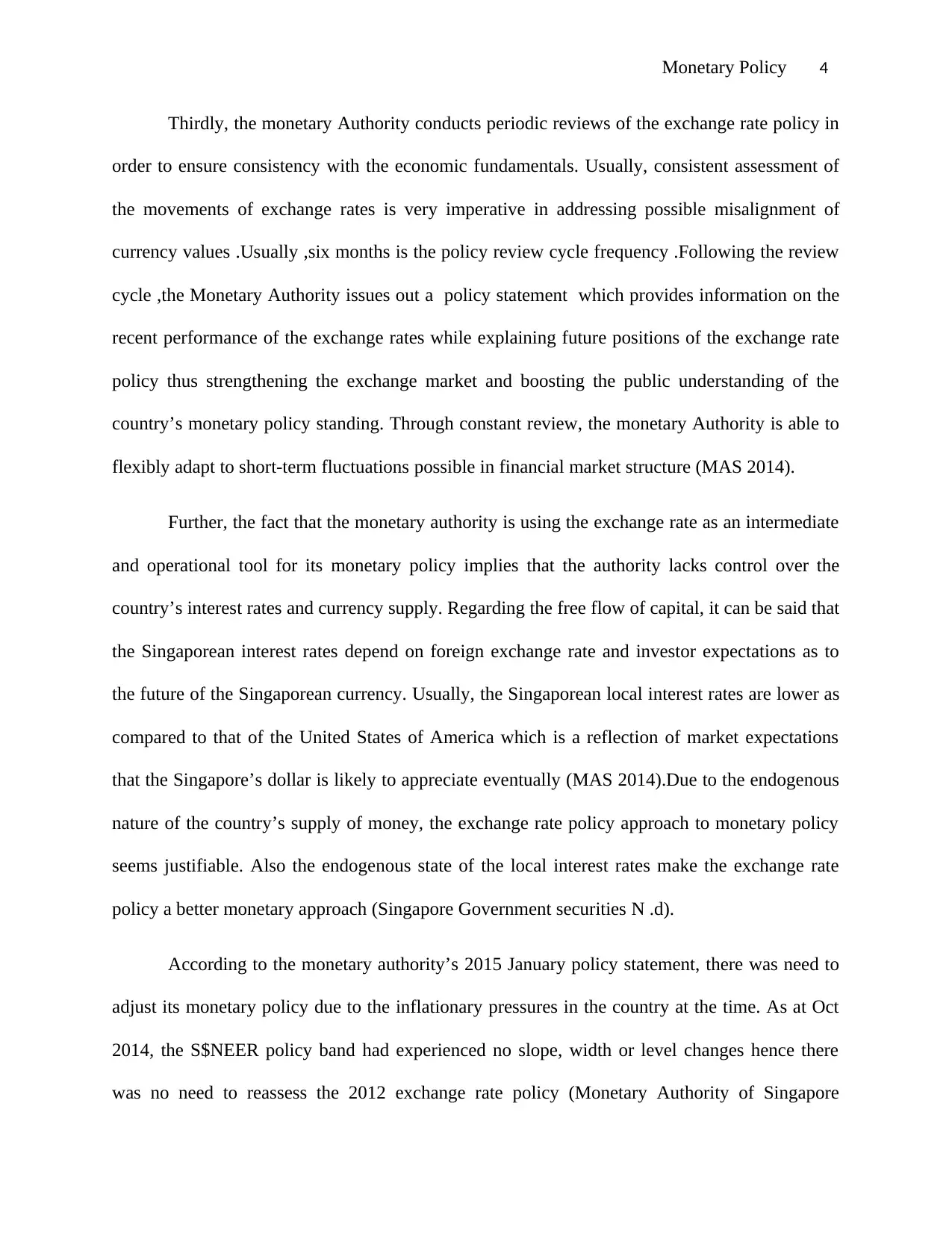
Monetary Policy 4
Thirdly, the monetary Authority conducts periodic reviews of the exchange rate policy in
order to ensure consistency with the economic fundamentals. Usually, consistent assessment of
the movements of exchange rates is very imperative in addressing possible misalignment of
currency values .Usually ,six months is the policy review cycle frequency .Following the review
cycle ,the Monetary Authority issues out a policy statement which provides information on the
recent performance of the exchange rates while explaining future positions of the exchange rate
policy thus strengthening the exchange market and boosting the public understanding of the
country’s monetary policy standing. Through constant review, the monetary Authority is able to
flexibly adapt to short-term fluctuations possible in financial market structure (MAS 2014).
Further, the fact that the monetary authority is using the exchange rate as an intermediate
and operational tool for its monetary policy implies that the authority lacks control over the
country’s interest rates and currency supply. Regarding the free flow of capital, it can be said that
the Singaporean interest rates depend on foreign exchange rate and investor expectations as to
the future of the Singaporean currency. Usually, the Singaporean local interest rates are lower as
compared to that of the United States of America which is a reflection of market expectations
that the Singapore’s dollar is likely to appreciate eventually (MAS 2014).Due to the endogenous
nature of the country’s supply of money, the exchange rate policy approach to monetary policy
seems justifiable. Also the endogenous state of the local interest rates make the exchange rate
policy a better monetary approach (Singapore Government securities N .d).
According to the monetary authority’s 2015 January policy statement, there was need to
adjust its monetary policy due to the inflationary pressures in the country at the time. As at Oct
2014, the S$NEER policy band had experienced no slope, width or level changes hence there
was no need to reassess the 2012 exchange rate policy (Monetary Authority of Singapore
Thirdly, the monetary Authority conducts periodic reviews of the exchange rate policy in
order to ensure consistency with the economic fundamentals. Usually, consistent assessment of
the movements of exchange rates is very imperative in addressing possible misalignment of
currency values .Usually ,six months is the policy review cycle frequency .Following the review
cycle ,the Monetary Authority issues out a policy statement which provides information on the
recent performance of the exchange rates while explaining future positions of the exchange rate
policy thus strengthening the exchange market and boosting the public understanding of the
country’s monetary policy standing. Through constant review, the monetary Authority is able to
flexibly adapt to short-term fluctuations possible in financial market structure (MAS 2014).
Further, the fact that the monetary authority is using the exchange rate as an intermediate
and operational tool for its monetary policy implies that the authority lacks control over the
country’s interest rates and currency supply. Regarding the free flow of capital, it can be said that
the Singaporean interest rates depend on foreign exchange rate and investor expectations as to
the future of the Singaporean currency. Usually, the Singaporean local interest rates are lower as
compared to that of the United States of America which is a reflection of market expectations
that the Singapore’s dollar is likely to appreciate eventually (MAS 2014).Due to the endogenous
nature of the country’s supply of money, the exchange rate policy approach to monetary policy
seems justifiable. Also the endogenous state of the local interest rates make the exchange rate
policy a better monetary approach (Singapore Government securities N .d).
According to the monetary authority’s 2015 January policy statement, there was need to
adjust its monetary policy due to the inflationary pressures in the country at the time. As at Oct
2014, the S$NEER policy band had experienced no slope, width or level changes hence there
was no need to reassess the 2012 exchange rate policy (Monetary Authority of Singapore
Secure Best Marks with AI Grader
Need help grading? Try our AI Grader for instant feedback on your assignments.
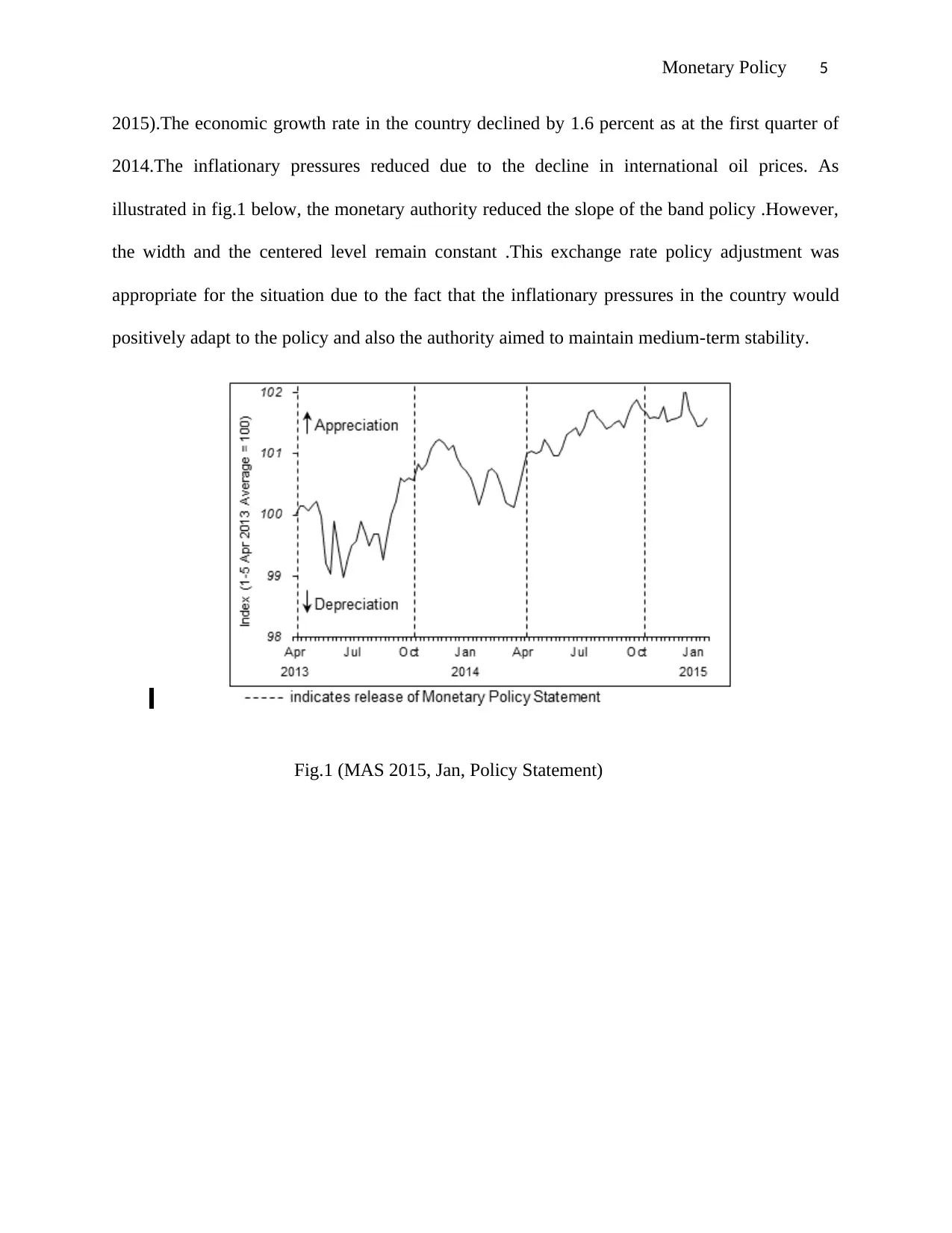
Monetary Policy 5
2015).The economic growth rate in the country declined by 1.6 percent as at the first quarter of
2014.The inflationary pressures reduced due to the decline in international oil prices. As
illustrated in fig.1 below, the monetary authority reduced the slope of the band policy .However,
the width and the centered level remain constant .This exchange rate policy adjustment was
appropriate for the situation due to the fact that the inflationary pressures in the country would
positively adapt to the policy and also the authority aimed to maintain medium-term stability.
Fig.1 (MAS 2015, Jan, Policy Statement)
2015).The economic growth rate in the country declined by 1.6 percent as at the first quarter of
2014.The inflationary pressures reduced due to the decline in international oil prices. As
illustrated in fig.1 below, the monetary authority reduced the slope of the band policy .However,
the width and the centered level remain constant .This exchange rate policy adjustment was
appropriate for the situation due to the fact that the inflationary pressures in the country would
positively adapt to the policy and also the authority aimed to maintain medium-term stability.
Fig.1 (MAS 2015, Jan, Policy Statement)
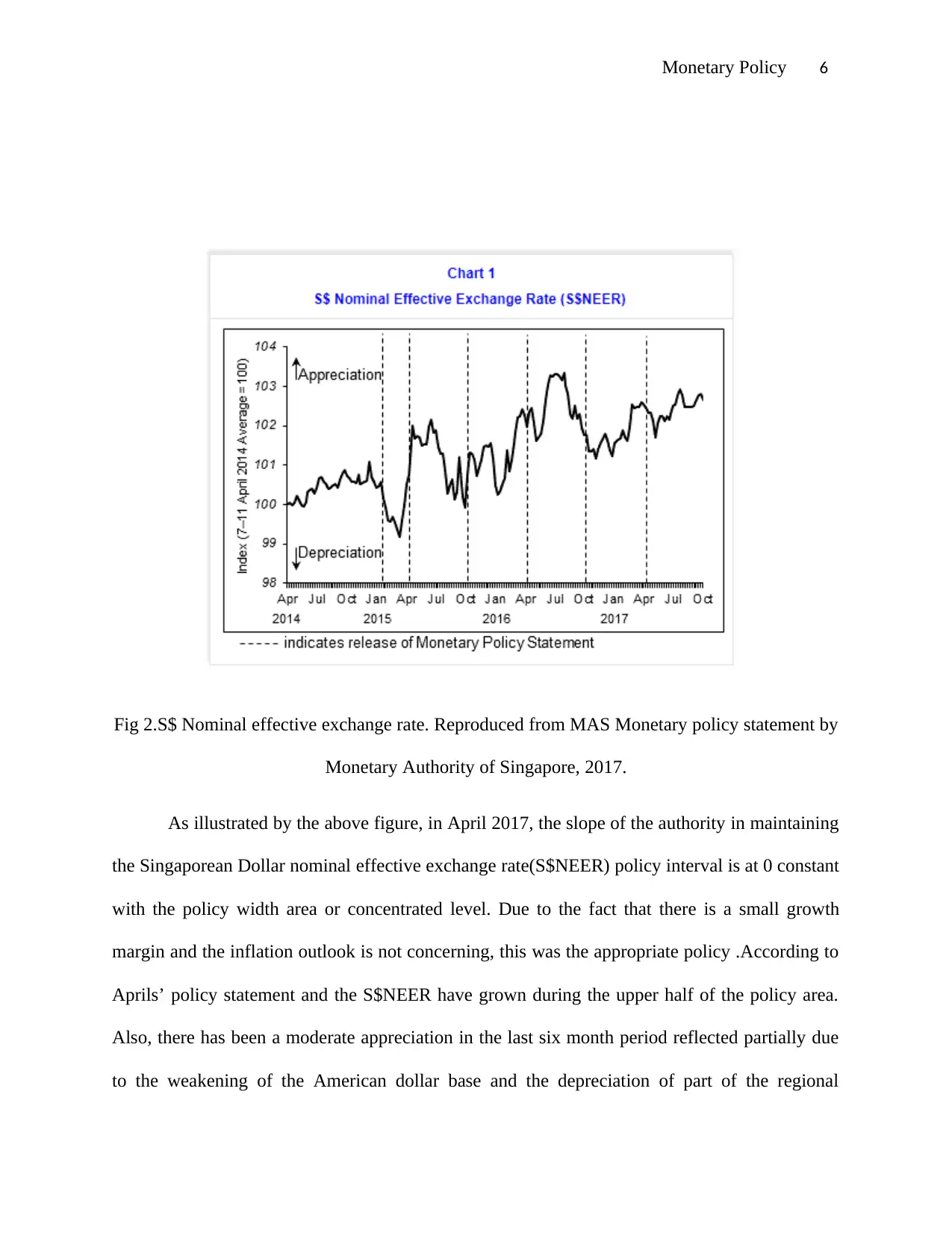
Monetary Policy 6
Fig 2.S$ Nominal effective exchange rate. Reproduced from MAS Monetary policy statement by
Monetary Authority of Singapore, 2017.
As illustrated by the above figure, in April 2017, the slope of the authority in maintaining
the Singaporean Dollar nominal effective exchange rate(S$NEER) policy interval is at 0 constant
with the policy width area or concentrated level. Due to the fact that there is a small growth
margin and the inflation outlook is not concerning, this was the appropriate policy .According to
Aprils’ policy statement and the S$NEER have grown during the upper half of the policy area.
Also, there has been a moderate appreciation in the last six month period reflected partially due
to the weakening of the American dollar base and the depreciation of part of the regional
Fig 2.S$ Nominal effective exchange rate. Reproduced from MAS Monetary policy statement by
Monetary Authority of Singapore, 2017.
As illustrated by the above figure, in April 2017, the slope of the authority in maintaining
the Singaporean Dollar nominal effective exchange rate(S$NEER) policy interval is at 0 constant
with the policy width area or concentrated level. Due to the fact that there is a small growth
margin and the inflation outlook is not concerning, this was the appropriate policy .According to
Aprils’ policy statement and the S$NEER have grown during the upper half of the policy area.
Also, there has been a moderate appreciation in the last six month period reflected partially due
to the weakening of the American dollar base and the depreciation of part of the regional
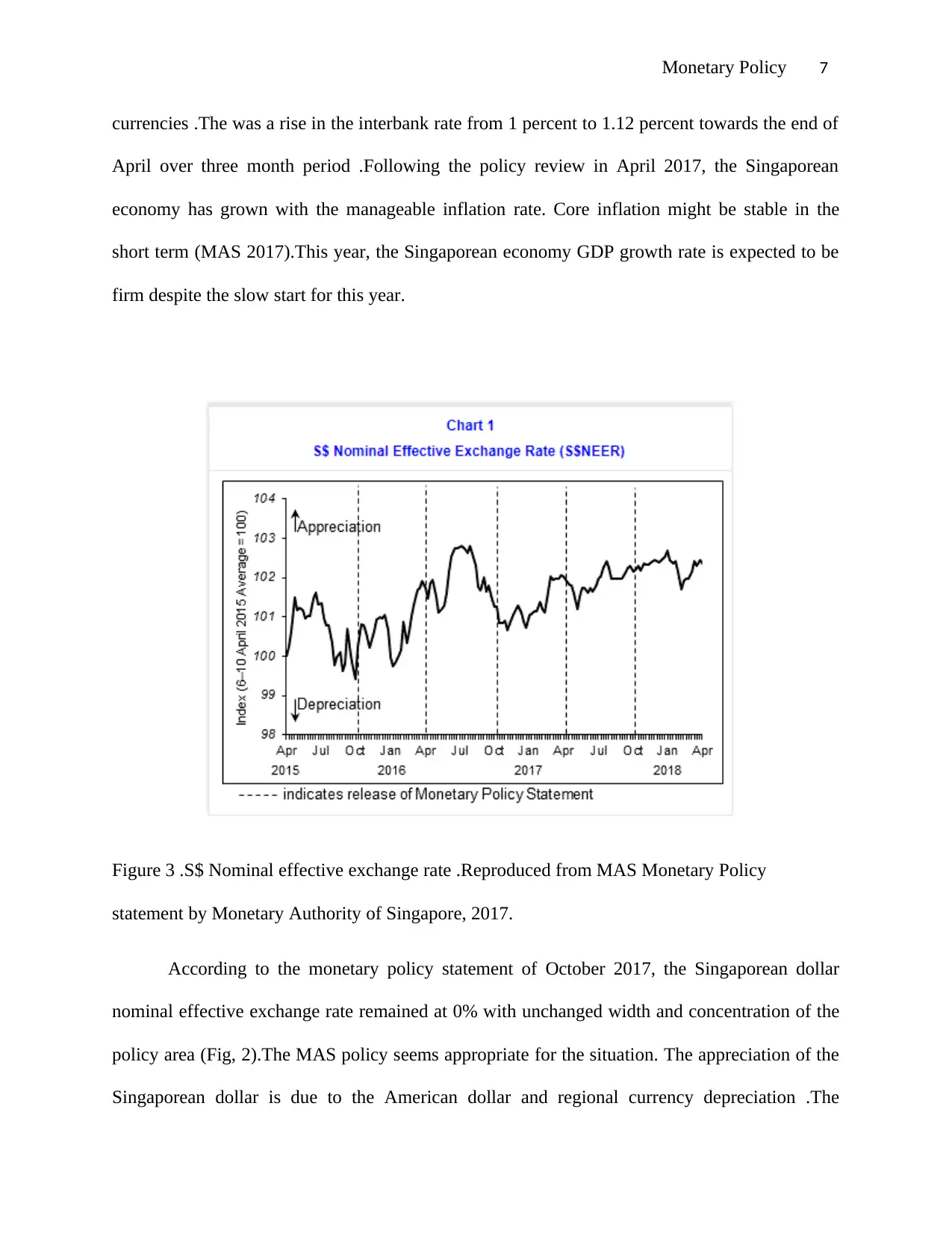
Monetary Policy 7
currencies .The was a rise in the interbank rate from 1 percent to 1.12 percent towards the end of
April over three month period .Following the policy review in April 2017, the Singaporean
economy has grown with the manageable inflation rate. Core inflation might be stable in the
short term (MAS 2017).This year, the Singaporean economy GDP growth rate is expected to be
firm despite the slow start for this year.
Figure 3 .S$ Nominal effective exchange rate .Reproduced from MAS Monetary Policy
statement by Monetary Authority of Singapore, 2017.
According to the monetary policy statement of October 2017, the Singaporean dollar
nominal effective exchange rate remained at 0% with unchanged width and concentration of the
policy area (Fig, 2).The MAS policy seems appropriate for the situation. The appreciation of the
Singaporean dollar is due to the American dollar and regional currency depreciation .The
currencies .The was a rise in the interbank rate from 1 percent to 1.12 percent towards the end of
April over three month period .Following the policy review in April 2017, the Singaporean
economy has grown with the manageable inflation rate. Core inflation might be stable in the
short term (MAS 2017).This year, the Singaporean economy GDP growth rate is expected to be
firm despite the slow start for this year.
Figure 3 .S$ Nominal effective exchange rate .Reproduced from MAS Monetary Policy
statement by Monetary Authority of Singapore, 2017.
According to the monetary policy statement of October 2017, the Singaporean dollar
nominal effective exchange rate remained at 0% with unchanged width and concentration of the
policy area (Fig, 2).The MAS policy seems appropriate for the situation. The appreciation of the
Singaporean dollar is due to the American dollar and regional currency depreciation .The
Paraphrase This Document
Need a fresh take? Get an instant paraphrase of this document with our AI Paraphraser
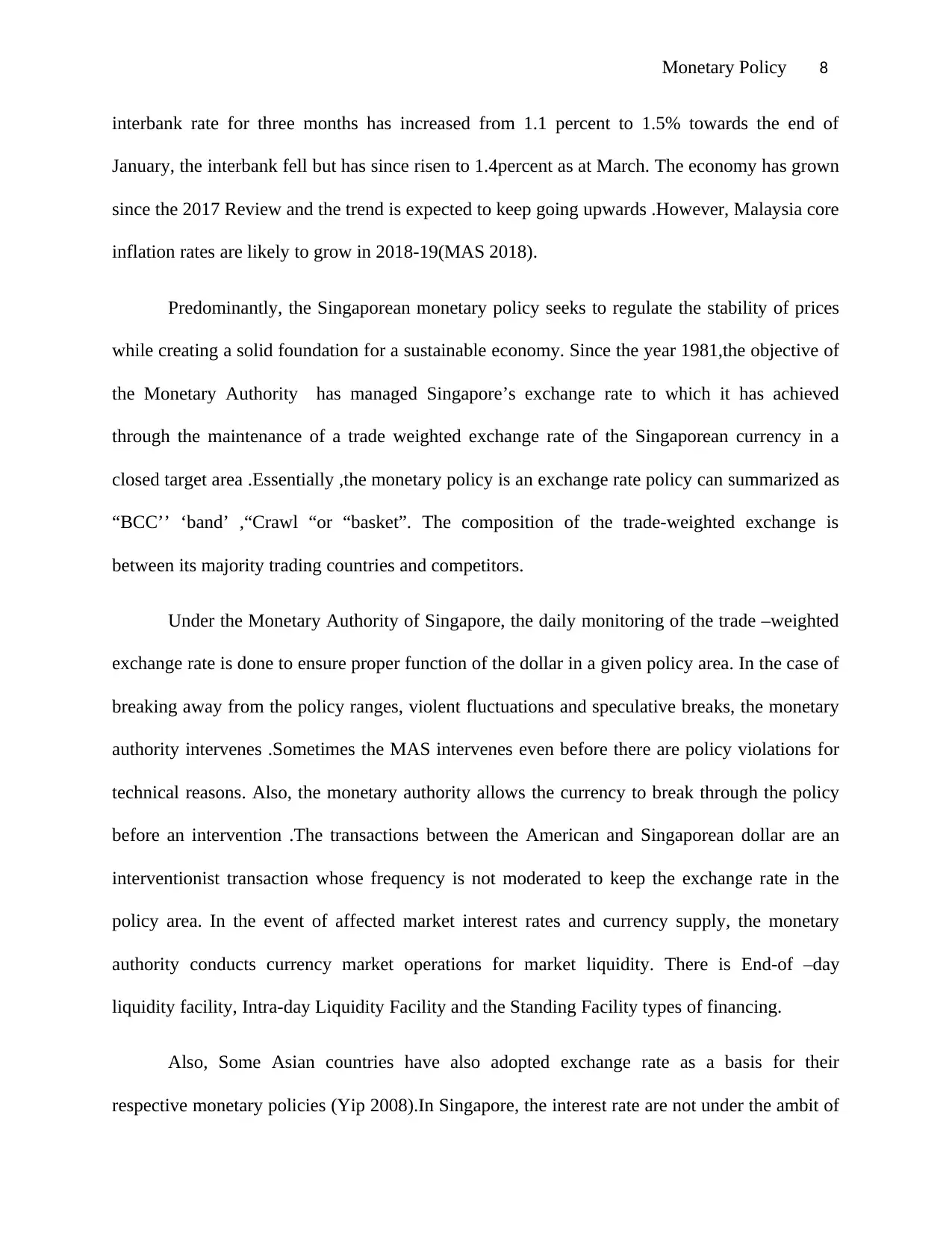
Monetary Policy 8
interbank rate for three months has increased from 1.1 percent to 1.5% towards the end of
January, the interbank fell but has since risen to 1.4percent as at March. The economy has grown
since the 2017 Review and the trend is expected to keep going upwards .However, Malaysia core
inflation rates are likely to grow in 2018-19(MAS 2018).
Predominantly, the Singaporean monetary policy seeks to regulate the stability of prices
while creating a solid foundation for a sustainable economy. Since the year 1981,the objective of
the Monetary Authority has managed Singapore’s exchange rate to which it has achieved
through the maintenance of a trade weighted exchange rate of the Singaporean currency in a
closed target area .Essentially ,the monetary policy is an exchange rate policy can summarized as
“BCC’’ ‘band’ ,“Crawl “or “basket”. The composition of the trade-weighted exchange is
between its majority trading countries and competitors.
Under the Monetary Authority of Singapore, the daily monitoring of the trade –weighted
exchange rate is done to ensure proper function of the dollar in a given policy area. In the case of
breaking away from the policy ranges, violent fluctuations and speculative breaks, the monetary
authority intervenes .Sometimes the MAS intervenes even before there are policy violations for
technical reasons. Also, the monetary authority allows the currency to break through the policy
before an intervention .The transactions between the American and Singaporean dollar are an
interventionist transaction whose frequency is not moderated to keep the exchange rate in the
policy area. In the event of affected market interest rates and currency supply, the monetary
authority conducts currency market operations for market liquidity. There is End-of –day
liquidity facility, Intra-day Liquidity Facility and the Standing Facility types of financing.
Also, Some Asian countries have also adopted exchange rate as a basis for their
respective monetary policies (Yip 2008).In Singapore, the interest rate are not under the ambit of
interbank rate for three months has increased from 1.1 percent to 1.5% towards the end of
January, the interbank fell but has since risen to 1.4percent as at March. The economy has grown
since the 2017 Review and the trend is expected to keep going upwards .However, Malaysia core
inflation rates are likely to grow in 2018-19(MAS 2018).
Predominantly, the Singaporean monetary policy seeks to regulate the stability of prices
while creating a solid foundation for a sustainable economy. Since the year 1981,the objective of
the Monetary Authority has managed Singapore’s exchange rate to which it has achieved
through the maintenance of a trade weighted exchange rate of the Singaporean currency in a
closed target area .Essentially ,the monetary policy is an exchange rate policy can summarized as
“BCC’’ ‘band’ ,“Crawl “or “basket”. The composition of the trade-weighted exchange is
between its majority trading countries and competitors.
Under the Monetary Authority of Singapore, the daily monitoring of the trade –weighted
exchange rate is done to ensure proper function of the dollar in a given policy area. In the case of
breaking away from the policy ranges, violent fluctuations and speculative breaks, the monetary
authority intervenes .Sometimes the MAS intervenes even before there are policy violations for
technical reasons. Also, the monetary authority allows the currency to break through the policy
before an intervention .The transactions between the American and Singaporean dollar are an
interventionist transaction whose frequency is not moderated to keep the exchange rate in the
policy area. In the event of affected market interest rates and currency supply, the monetary
authority conducts currency market operations for market liquidity. There is End-of –day
liquidity facility, Intra-day Liquidity Facility and the Standing Facility types of financing.
Also, Some Asian countries have also adopted exchange rate as a basis for their
respective monetary policies (Yip 2008).In Singapore, the interest rate are not under the ambit of
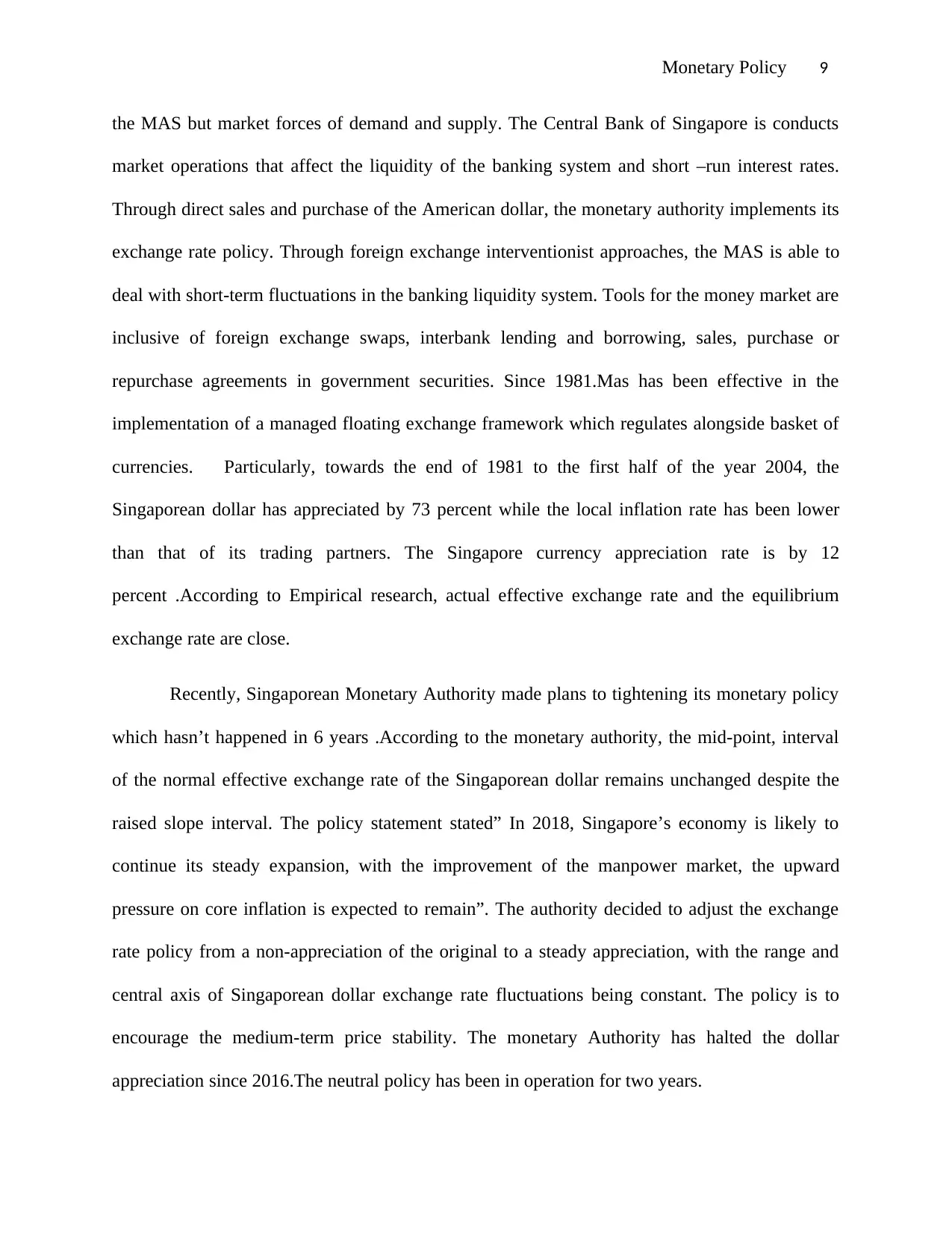
Monetary Policy 9
the MAS but market forces of demand and supply. The Central Bank of Singapore is conducts
market operations that affect the liquidity of the banking system and short –run interest rates.
Through direct sales and purchase of the American dollar, the monetary authority implements its
exchange rate policy. Through foreign exchange interventionist approaches, the MAS is able to
deal with short-term fluctuations in the banking liquidity system. Tools for the money market are
inclusive of foreign exchange swaps, interbank lending and borrowing, sales, purchase or
repurchase agreements in government securities. Since 1981.Mas has been effective in the
implementation of a managed floating exchange framework which regulates alongside basket of
currencies. Particularly, towards the end of 1981 to the first half of the year 2004, the
Singaporean dollar has appreciated by 73 percent while the local inflation rate has been lower
than that of its trading partners. The Singapore currency appreciation rate is by 12
percent .According to Empirical research, actual effective exchange rate and the equilibrium
exchange rate are close.
Recently, Singaporean Monetary Authority made plans to tightening its monetary policy
which hasn’t happened in 6 years .According to the monetary authority, the mid-point, interval
of the normal effective exchange rate of the Singaporean dollar remains unchanged despite the
raised slope interval. The policy statement stated” In 2018, Singapore’s economy is likely to
continue its steady expansion, with the improvement of the manpower market, the upward
pressure on core inflation is expected to remain”. The authority decided to adjust the exchange
rate policy from a non-appreciation of the original to a steady appreciation, with the range and
central axis of Singaporean dollar exchange rate fluctuations being constant. The policy is to
encourage the medium-term price stability. The monetary Authority has halted the dollar
appreciation since 2016.The neutral policy has been in operation for two years.
the MAS but market forces of demand and supply. The Central Bank of Singapore is conducts
market operations that affect the liquidity of the banking system and short –run interest rates.
Through direct sales and purchase of the American dollar, the monetary authority implements its
exchange rate policy. Through foreign exchange interventionist approaches, the MAS is able to
deal with short-term fluctuations in the banking liquidity system. Tools for the money market are
inclusive of foreign exchange swaps, interbank lending and borrowing, sales, purchase or
repurchase agreements in government securities. Since 1981.Mas has been effective in the
implementation of a managed floating exchange framework which regulates alongside basket of
currencies. Particularly, towards the end of 1981 to the first half of the year 2004, the
Singaporean dollar has appreciated by 73 percent while the local inflation rate has been lower
than that of its trading partners. The Singapore currency appreciation rate is by 12
percent .According to Empirical research, actual effective exchange rate and the equilibrium
exchange rate are close.
Recently, Singaporean Monetary Authority made plans to tightening its monetary policy
which hasn’t happened in 6 years .According to the monetary authority, the mid-point, interval
of the normal effective exchange rate of the Singaporean dollar remains unchanged despite the
raised slope interval. The policy statement stated” In 2018, Singapore’s economy is likely to
continue its steady expansion, with the improvement of the manpower market, the upward
pressure on core inflation is expected to remain”. The authority decided to adjust the exchange
rate policy from a non-appreciation of the original to a steady appreciation, with the range and
central axis of Singaporean dollar exchange rate fluctuations being constant. The policy is to
encourage the medium-term price stability. The monetary Authority has halted the dollar
appreciation since 2016.The neutral policy has been in operation for two years.
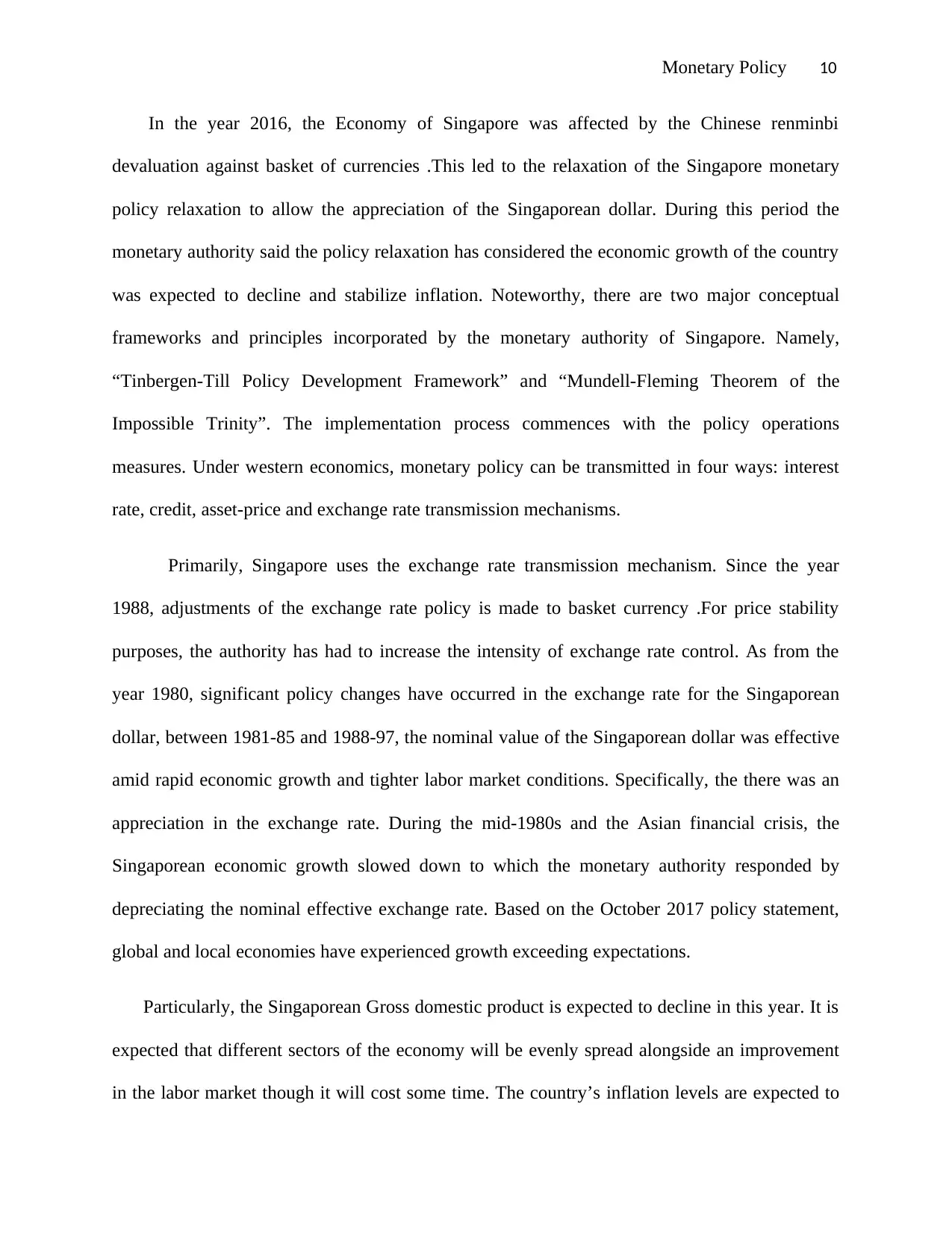
Monetary Policy 10
In the year 2016, the Economy of Singapore was affected by the Chinese renminbi
devaluation against basket of currencies .This led to the relaxation of the Singapore monetary
policy relaxation to allow the appreciation of the Singaporean dollar. During this period the
monetary authority said the policy relaxation has considered the economic growth of the country
was expected to decline and stabilize inflation. Noteworthy, there are two major conceptual
frameworks and principles incorporated by the monetary authority of Singapore. Namely,
“Tinbergen-Till Policy Development Framework” and “Mundell-Fleming Theorem of the
Impossible Trinity”. The implementation process commences with the policy operations
measures. Under western economics, monetary policy can be transmitted in four ways: interest
rate, credit, asset-price and exchange rate transmission mechanisms.
Primarily, Singapore uses the exchange rate transmission mechanism. Since the year
1988, adjustments of the exchange rate policy is made to basket currency .For price stability
purposes, the authority has had to increase the intensity of exchange rate control. As from the
year 1980, significant policy changes have occurred in the exchange rate for the Singaporean
dollar, between 1981-85 and 1988-97, the nominal value of the Singaporean dollar was effective
amid rapid economic growth and tighter labor market conditions. Specifically, the there was an
appreciation in the exchange rate. During the mid-1980s and the Asian financial crisis, the
Singaporean economic growth slowed down to which the monetary authority responded by
depreciating the nominal effective exchange rate. Based on the October 2017 policy statement,
global and local economies have experienced growth exceeding expectations.
Particularly, the Singaporean Gross domestic product is expected to decline in this year. It is
expected that different sectors of the economy will be evenly spread alongside an improvement
in the labor market though it will cost some time. The country’s inflation levels are expected to
In the year 2016, the Economy of Singapore was affected by the Chinese renminbi
devaluation against basket of currencies .This led to the relaxation of the Singapore monetary
policy relaxation to allow the appreciation of the Singaporean dollar. During this period the
monetary authority said the policy relaxation has considered the economic growth of the country
was expected to decline and stabilize inflation. Noteworthy, there are two major conceptual
frameworks and principles incorporated by the monetary authority of Singapore. Namely,
“Tinbergen-Till Policy Development Framework” and “Mundell-Fleming Theorem of the
Impossible Trinity”. The implementation process commences with the policy operations
measures. Under western economics, monetary policy can be transmitted in four ways: interest
rate, credit, asset-price and exchange rate transmission mechanisms.
Primarily, Singapore uses the exchange rate transmission mechanism. Since the year
1988, adjustments of the exchange rate policy is made to basket currency .For price stability
purposes, the authority has had to increase the intensity of exchange rate control. As from the
year 1980, significant policy changes have occurred in the exchange rate for the Singaporean
dollar, between 1981-85 and 1988-97, the nominal value of the Singaporean dollar was effective
amid rapid economic growth and tighter labor market conditions. Specifically, the there was an
appreciation in the exchange rate. During the mid-1980s and the Asian financial crisis, the
Singaporean economic growth slowed down to which the monetary authority responded by
depreciating the nominal effective exchange rate. Based on the October 2017 policy statement,
global and local economies have experienced growth exceeding expectations.
Particularly, the Singaporean Gross domestic product is expected to decline in this year. It is
expected that different sectors of the economy will be evenly spread alongside an improvement
in the labor market though it will cost some time. The country’s inflation levels are expected to
Secure Best Marks with AI Grader
Need help grading? Try our AI Grader for instant feedback on your assignments.
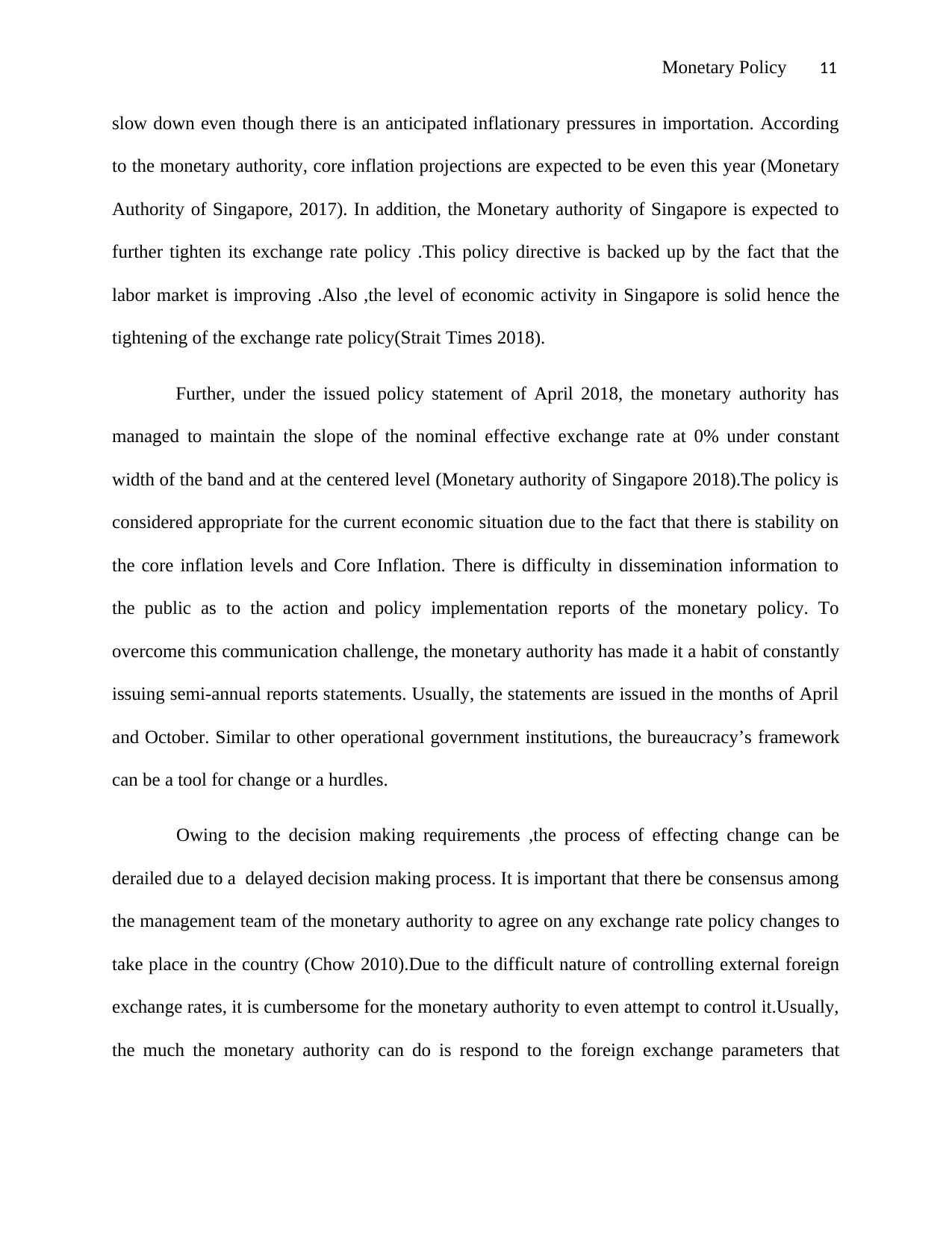
Monetary Policy 11
slow down even though there is an anticipated inflationary pressures in importation. According
to the monetary authority, core inflation projections are expected to be even this year (Monetary
Authority of Singapore, 2017). In addition, the Monetary authority of Singapore is expected to
further tighten its exchange rate policy .This policy directive is backed up by the fact that the
labor market is improving .Also ,the level of economic activity in Singapore is solid hence the
tightening of the exchange rate policy(Strait Times 2018).
Further, under the issued policy statement of April 2018, the monetary authority has
managed to maintain the slope of the nominal effective exchange rate at 0% under constant
width of the band and at the centered level (Monetary authority of Singapore 2018).The policy is
considered appropriate for the current economic situation due to the fact that there is stability on
the core inflation levels and Core Inflation. There is difficulty in dissemination information to
the public as to the action and policy implementation reports of the monetary policy. To
overcome this communication challenge, the monetary authority has made it a habit of constantly
issuing semi-annual reports statements. Usually, the statements are issued in the months of April
and October. Similar to other operational government institutions, the bureaucracy’s framework
can be a tool for change or a hurdles.
Owing to the decision making requirements ,the process of effecting change can be
derailed due to a delayed decision making process. It is important that there be consensus among
the management team of the monetary authority to agree on any exchange rate policy changes to
take place in the country (Chow 2010).Due to the difficult nature of controlling external foreign
exchange rates, it is cumbersome for the monetary authority to even attempt to control it.Usually,
the much the monetary authority can do is respond to the foreign exchange parameters that
slow down even though there is an anticipated inflationary pressures in importation. According
to the monetary authority, core inflation projections are expected to be even this year (Monetary
Authority of Singapore, 2017). In addition, the Monetary authority of Singapore is expected to
further tighten its exchange rate policy .This policy directive is backed up by the fact that the
labor market is improving .Also ,the level of economic activity in Singapore is solid hence the
tightening of the exchange rate policy(Strait Times 2018).
Further, under the issued policy statement of April 2018, the monetary authority has
managed to maintain the slope of the nominal effective exchange rate at 0% under constant
width of the band and at the centered level (Monetary authority of Singapore 2018).The policy is
considered appropriate for the current economic situation due to the fact that there is stability on
the core inflation levels and Core Inflation. There is difficulty in dissemination information to
the public as to the action and policy implementation reports of the monetary policy. To
overcome this communication challenge, the monetary authority has made it a habit of constantly
issuing semi-annual reports statements. Usually, the statements are issued in the months of April
and October. Similar to other operational government institutions, the bureaucracy’s framework
can be a tool for change or a hurdles.
Owing to the decision making requirements ,the process of effecting change can be
derailed due to a delayed decision making process. It is important that there be consensus among
the management team of the monetary authority to agree on any exchange rate policy changes to
take place in the country (Chow 2010).Due to the difficult nature of controlling external foreign
exchange rates, it is cumbersome for the monetary authority to even attempt to control it.Usually,
the much the monetary authority can do is respond to the foreign exchange parameters that
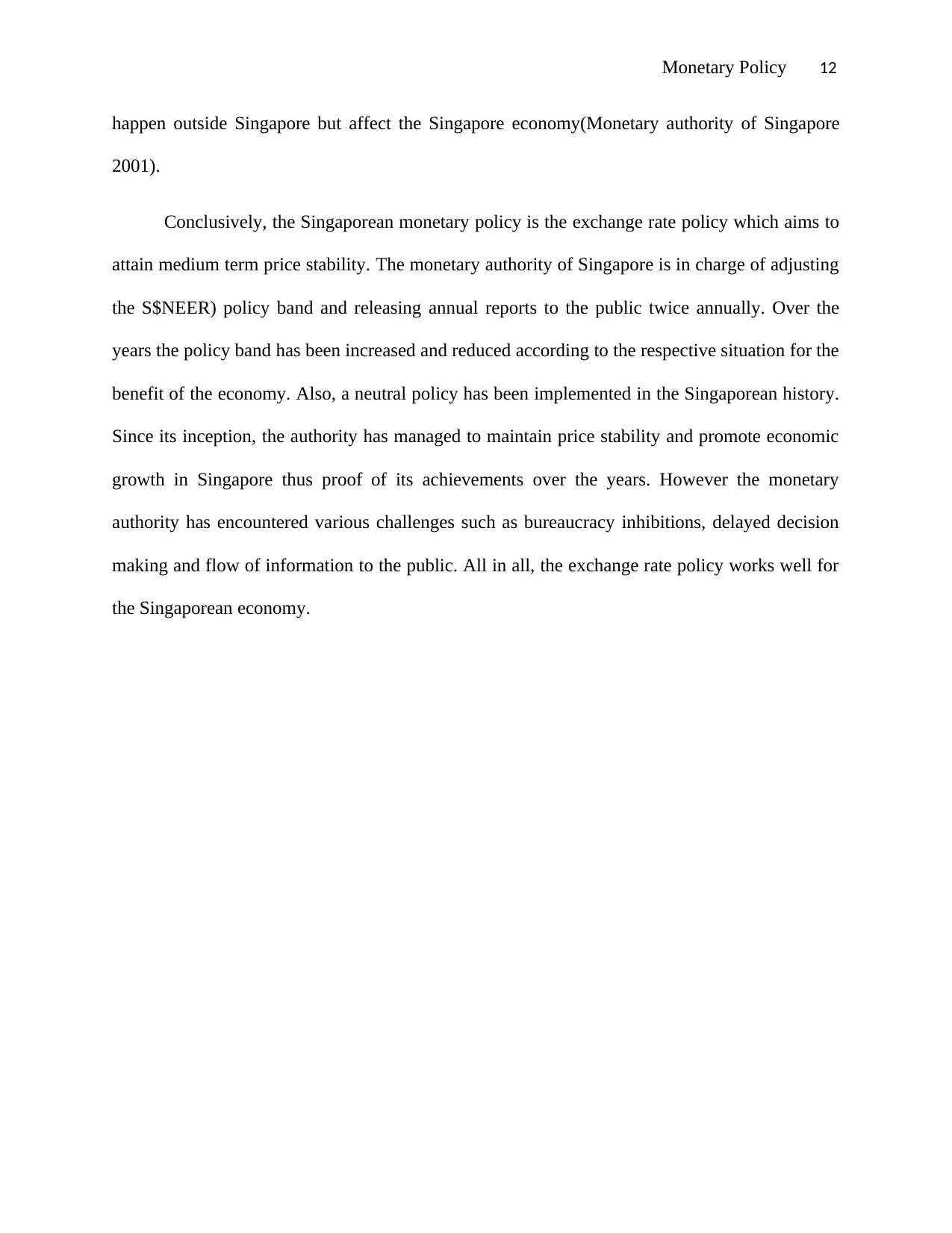
Monetary Policy 12
happen outside Singapore but affect the Singapore economy(Monetary authority of Singapore
2001).
Conclusively, the Singaporean monetary policy is the exchange rate policy which aims to
attain medium term price stability. The monetary authority of Singapore is in charge of adjusting
the S$NEER) policy band and releasing annual reports to the public twice annually. Over the
years the policy band has been increased and reduced according to the respective situation for the
benefit of the economy. Also, a neutral policy has been implemented in the Singaporean history.
Since its inception, the authority has managed to maintain price stability and promote economic
growth in Singapore thus proof of its achievements over the years. However the monetary
authority has encountered various challenges such as bureaucracy inhibitions, delayed decision
making and flow of information to the public. All in all, the exchange rate policy works well for
the Singaporean economy.
happen outside Singapore but affect the Singapore economy(Monetary authority of Singapore
2001).
Conclusively, the Singaporean monetary policy is the exchange rate policy which aims to
attain medium term price stability. The monetary authority of Singapore is in charge of adjusting
the S$NEER) policy band and releasing annual reports to the public twice annually. Over the
years the policy band has been increased and reduced according to the respective situation for the
benefit of the economy. Also, a neutral policy has been implemented in the Singaporean history.
Since its inception, the authority has managed to maintain price stability and promote economic
growth in Singapore thus proof of its achievements over the years. However the monetary
authority has encountered various challenges such as bureaucracy inhibitions, delayed decision
making and flow of information to the public. All in all, the exchange rate policy works well for
the Singaporean economy.
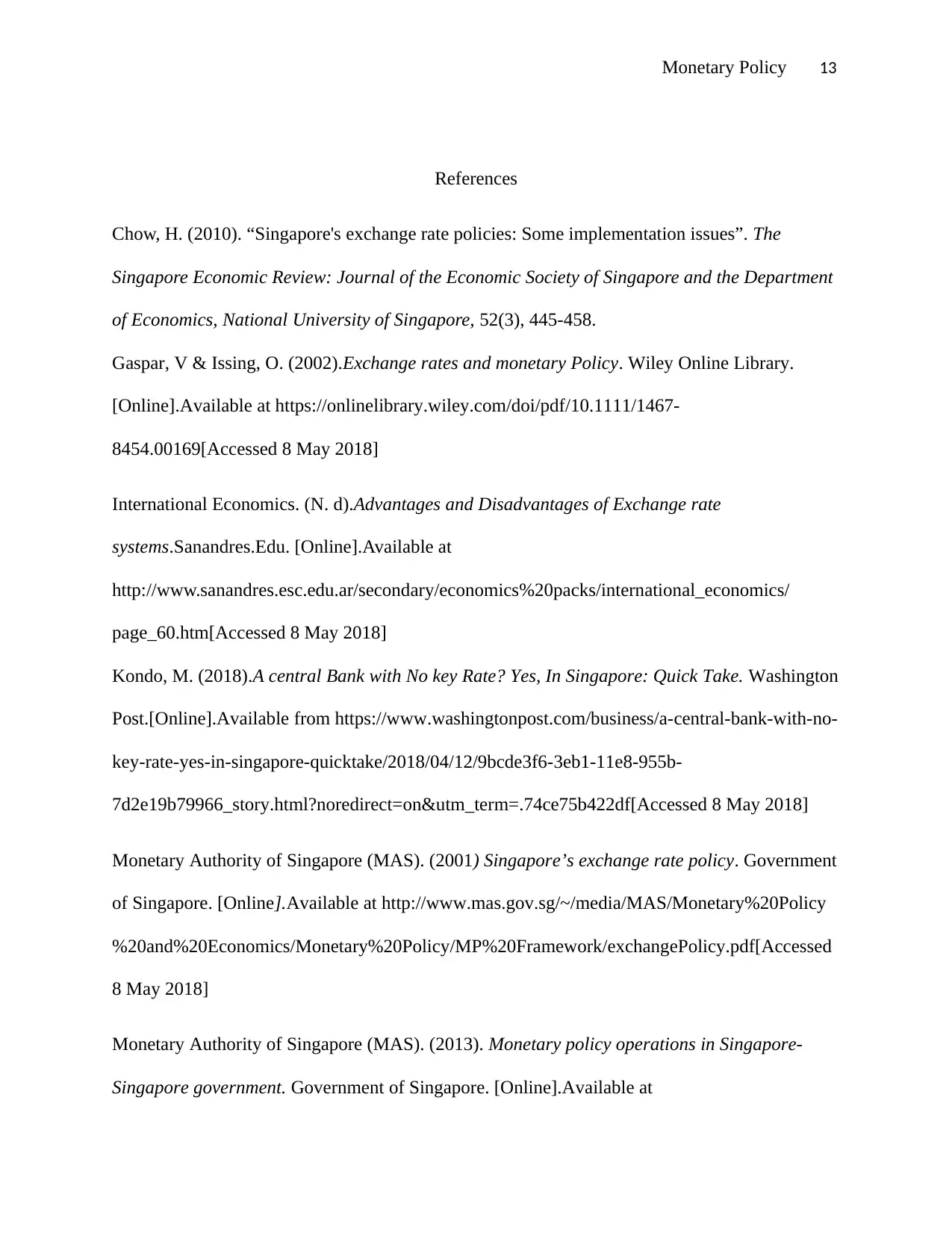
Monetary Policy 13
References
Chow, H. (2010). “Singapore's exchange rate policies: Some implementation issues”. The
Singapore Economic Review: Journal of the Economic Society of Singapore and the Department
of Economics, National University of Singapore, 52(3), 445-458.
Gaspar, V & Issing, O. (2002).Exchange rates and monetary Policy. Wiley Online Library.
[Online].Available at https://onlinelibrary.wiley.com/doi/pdf/10.1111/1467-
8454.00169[Accessed 8 May 2018]
International Economics. (N. d).Advantages and Disadvantages of Exchange rate
systems.Sanandres.Edu. [Online].Available at
http://www.sanandres.esc.edu.ar/secondary/economics%20packs/international_economics/
page_60.htm[Accessed 8 May 2018]
Kondo, M. (2018).A central Bank with No key Rate? Yes, In Singapore: Quick Take. Washington
Post.[Online].Available from https://www.washingtonpost.com/business/a-central-bank-with-no-
key-rate-yes-in-singapore-quicktake/2018/04/12/9bcde3f6-3eb1-11e8-955b-
7d2e19b79966_story.html?noredirect=on&utm_term=.74ce75b422df[Accessed 8 May 2018]
Monetary Authority of Singapore (MAS). (2001) Singapore’s exchange rate policy. Government
of Singapore. [Online].Available at http://www.mas.gov.sg/~/media/MAS/Monetary%20Policy
%20and%20Economics/Monetary%20Policy/MP%20Framework/exchangePolicy.pdf[Accessed
8 May 2018]
Monetary Authority of Singapore (MAS). (2013). Monetary policy operations in Singapore-
Singapore government. Government of Singapore. [Online].Available at
References
Chow, H. (2010). “Singapore's exchange rate policies: Some implementation issues”. The
Singapore Economic Review: Journal of the Economic Society of Singapore and the Department
of Economics, National University of Singapore, 52(3), 445-458.
Gaspar, V & Issing, O. (2002).Exchange rates and monetary Policy. Wiley Online Library.
[Online].Available at https://onlinelibrary.wiley.com/doi/pdf/10.1111/1467-
8454.00169[Accessed 8 May 2018]
International Economics. (N. d).Advantages and Disadvantages of Exchange rate
systems.Sanandres.Edu. [Online].Available at
http://www.sanandres.esc.edu.ar/secondary/economics%20packs/international_economics/
page_60.htm[Accessed 8 May 2018]
Kondo, M. (2018).A central Bank with No key Rate? Yes, In Singapore: Quick Take. Washington
Post.[Online].Available from https://www.washingtonpost.com/business/a-central-bank-with-no-
key-rate-yes-in-singapore-quicktake/2018/04/12/9bcde3f6-3eb1-11e8-955b-
7d2e19b79966_story.html?noredirect=on&utm_term=.74ce75b422df[Accessed 8 May 2018]
Monetary Authority of Singapore (MAS). (2001) Singapore’s exchange rate policy. Government
of Singapore. [Online].Available at http://www.mas.gov.sg/~/media/MAS/Monetary%20Policy
%20and%20Economics/Monetary%20Policy/MP%20Framework/exchangePolicy.pdf[Accessed
8 May 2018]
Monetary Authority of Singapore (MAS). (2013). Monetary policy operations in Singapore-
Singapore government. Government of Singapore. [Online].Available at
Paraphrase This Document
Need a fresh take? Get an instant paraphrase of this document with our AI Paraphraser
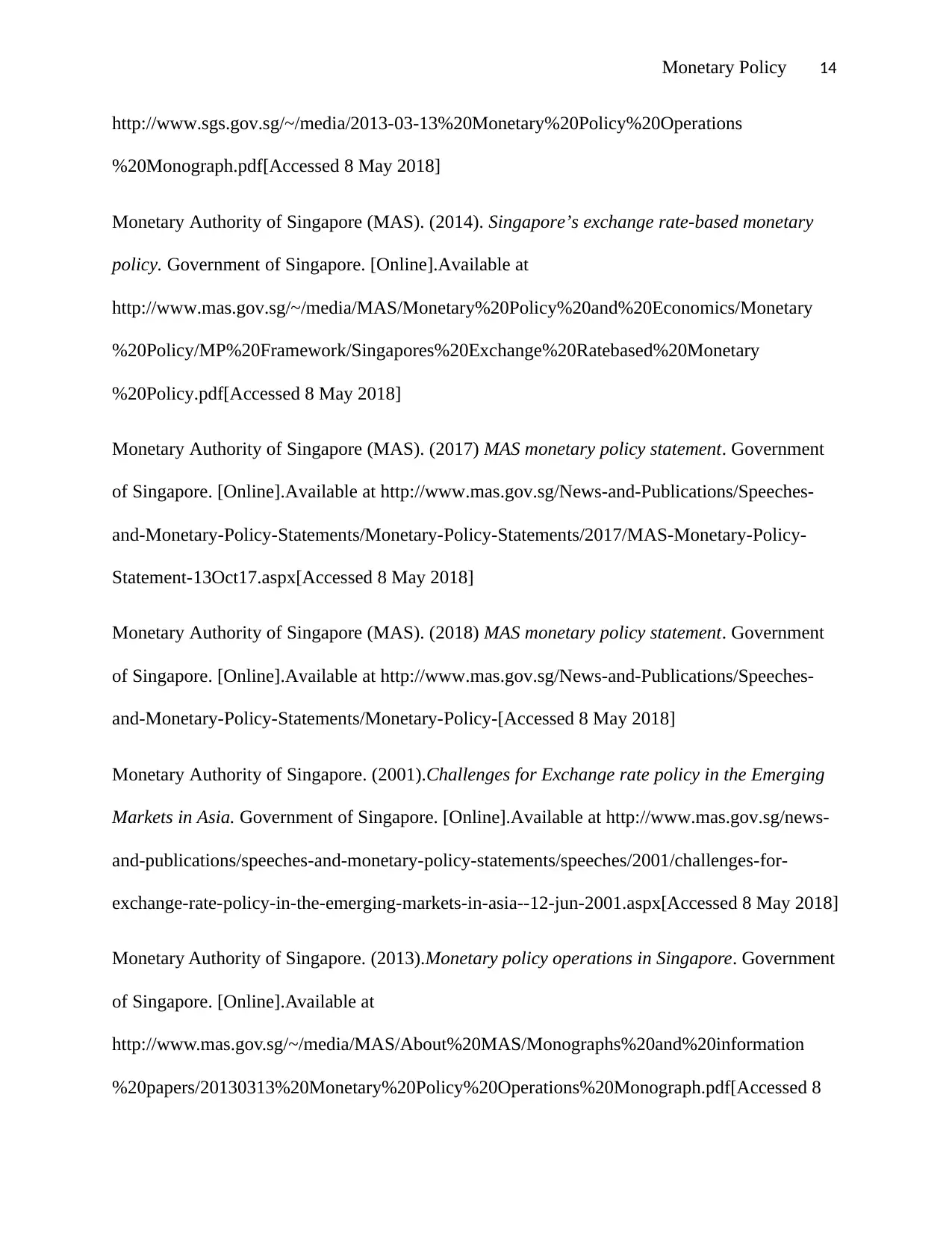
Monetary Policy 14
http://www.sgs.gov.sg/~/media/2013-03-13%20Monetary%20Policy%20Operations
%20Monograph.pdf[Accessed 8 May 2018]
Monetary Authority of Singapore (MAS). (2014). Singapore’s exchange rate-based monetary
policy. Government of Singapore. [Online].Available at
http://www.mas.gov.sg/~/media/MAS/Monetary%20Policy%20and%20Economics/Monetary
%20Policy/MP%20Framework/Singapores%20Exchange%20Ratebased%20Monetary
%20Policy.pdf[Accessed 8 May 2018]
Monetary Authority of Singapore (MAS). (2017) MAS monetary policy statement. Government
of Singapore. [Online].Available at http://www.mas.gov.sg/News-and-Publications/Speeches-
and-Monetary-Policy-Statements/Monetary-Policy-Statements/2017/MAS-Monetary-Policy-
Statement-13Oct17.aspx[Accessed 8 May 2018]
Monetary Authority of Singapore (MAS). (2018) MAS monetary policy statement. Government
of Singapore. [Online].Available at http://www.mas.gov.sg/News-and-Publications/Speeches-
and-Monetary-Policy-Statements/Monetary-Policy-[Accessed 8 May 2018]
Monetary Authority of Singapore. (2001).Challenges for Exchange rate policy in the Emerging
Markets in Asia. Government of Singapore. [Online].Available at http://www.mas.gov.sg/news-
and-publications/speeches-and-monetary-policy-statements/speeches/2001/challenges-for-
exchange-rate-policy-in-the-emerging-markets-in-asia--12-jun-2001.aspx[Accessed 8 May 2018]
Monetary Authority of Singapore. (2013).Monetary policy operations in Singapore. Government
of Singapore. [Online].Available at
http://www.mas.gov.sg/~/media/MAS/About%20MAS/Monographs%20and%20information
%20papers/20130313%20Monetary%20Policy%20Operations%20Monograph.pdf[Accessed 8
http://www.sgs.gov.sg/~/media/2013-03-13%20Monetary%20Policy%20Operations
%20Monograph.pdf[Accessed 8 May 2018]
Monetary Authority of Singapore (MAS). (2014). Singapore’s exchange rate-based monetary
policy. Government of Singapore. [Online].Available at
http://www.mas.gov.sg/~/media/MAS/Monetary%20Policy%20and%20Economics/Monetary
%20Policy/MP%20Framework/Singapores%20Exchange%20Ratebased%20Monetary
%20Policy.pdf[Accessed 8 May 2018]
Monetary Authority of Singapore (MAS). (2017) MAS monetary policy statement. Government
of Singapore. [Online].Available at http://www.mas.gov.sg/News-and-Publications/Speeches-
and-Monetary-Policy-Statements/Monetary-Policy-Statements/2017/MAS-Monetary-Policy-
Statement-13Oct17.aspx[Accessed 8 May 2018]
Monetary Authority of Singapore (MAS). (2018) MAS monetary policy statement. Government
of Singapore. [Online].Available at http://www.mas.gov.sg/News-and-Publications/Speeches-
and-Monetary-Policy-Statements/Monetary-Policy-[Accessed 8 May 2018]
Monetary Authority of Singapore. (2001).Challenges for Exchange rate policy in the Emerging
Markets in Asia. Government of Singapore. [Online].Available at http://www.mas.gov.sg/news-
and-publications/speeches-and-monetary-policy-statements/speeches/2001/challenges-for-
exchange-rate-policy-in-the-emerging-markets-in-asia--12-jun-2001.aspx[Accessed 8 May 2018]
Monetary Authority of Singapore. (2013).Monetary policy operations in Singapore. Government
of Singapore. [Online].Available at
http://www.mas.gov.sg/~/media/MAS/About%20MAS/Monographs%20and%20information
%20papers/20130313%20Monetary%20Policy%20Operations%20Monograph.pdf[Accessed 8
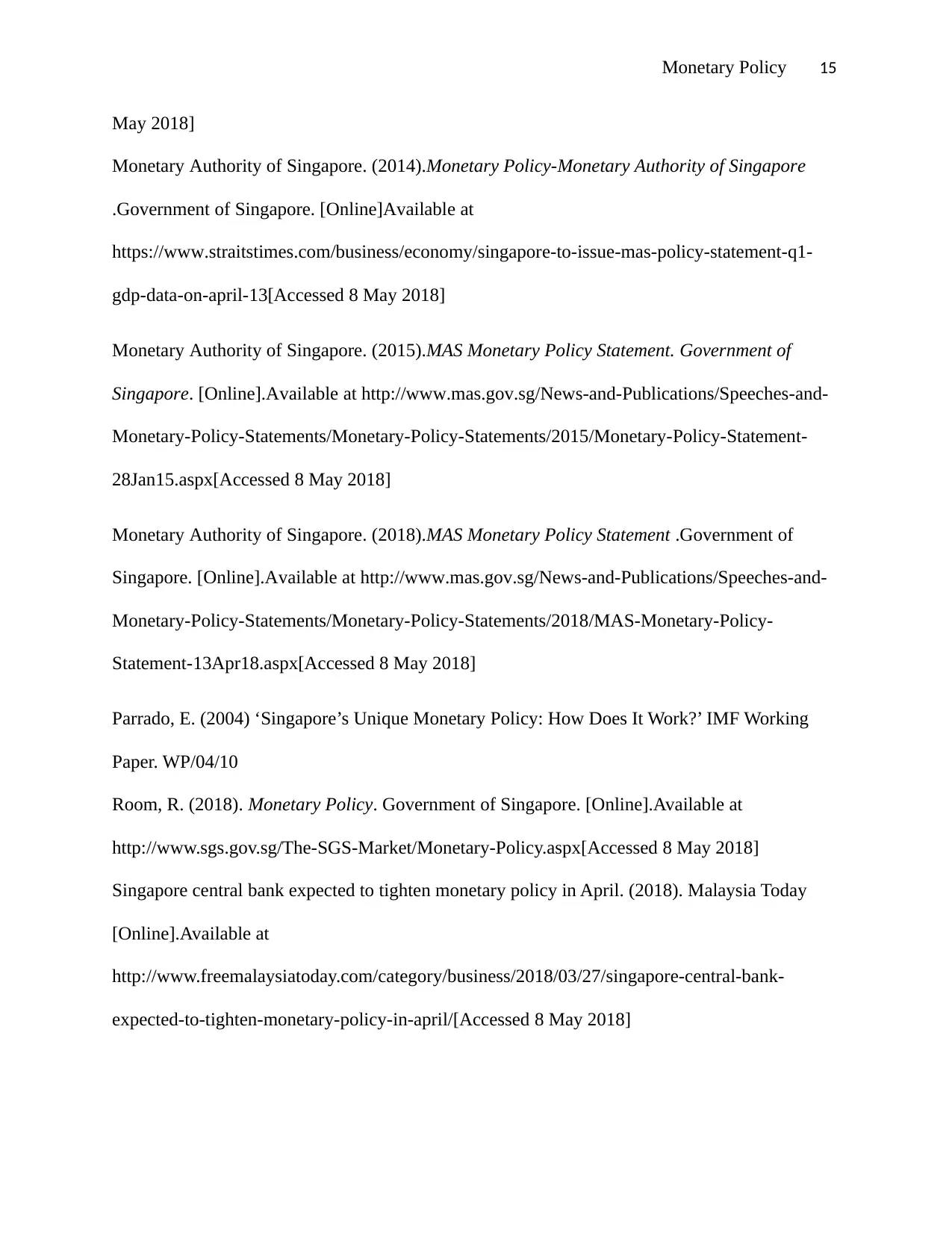
Monetary Policy 15
May 2018]
Monetary Authority of Singapore. (2014).Monetary Policy-Monetary Authority of Singapore
.Government of Singapore. [Online]Available at
https://www.straitstimes.com/business/economy/singapore-to-issue-mas-policy-statement-q1-
gdp-data-on-april-13[Accessed 8 May 2018]
Monetary Authority of Singapore. (2015).MAS Monetary Policy Statement. Government of
Singapore. [Online].Available at http://www.mas.gov.sg/News-and-Publications/Speeches-and-
Monetary-Policy-Statements/Monetary-Policy-Statements/2015/Monetary-Policy-Statement-
28Jan15.aspx[Accessed 8 May 2018]
Monetary Authority of Singapore. (2018).MAS Monetary Policy Statement .Government of
Singapore. [Online].Available at http://www.mas.gov.sg/News-and-Publications/Speeches-and-
Monetary-Policy-Statements/Monetary-Policy-Statements/2018/MAS-Monetary-Policy-
Statement-13Apr18.aspx[Accessed 8 May 2018]
Parrado, E. (2004) ‘Singapore’s Unique Monetary Policy: How Does It Work?’ IMF Working
Paper. WP/04/10
Room, R. (2018). Monetary Policy. Government of Singapore. [Online].Available at
http://www.sgs.gov.sg/The-SGS-Market/Monetary-Policy.aspx[Accessed 8 May 2018]
Singapore central bank expected to tighten monetary policy in April. (2018). Malaysia Today
[Online].Available at
http://www.freemalaysiatoday.com/category/business/2018/03/27/singapore-central-bank-
expected-to-tighten-monetary-policy-in-april/[Accessed 8 May 2018]
May 2018]
Monetary Authority of Singapore. (2014).Monetary Policy-Monetary Authority of Singapore
.Government of Singapore. [Online]Available at
https://www.straitstimes.com/business/economy/singapore-to-issue-mas-policy-statement-q1-
gdp-data-on-april-13[Accessed 8 May 2018]
Monetary Authority of Singapore. (2015).MAS Monetary Policy Statement. Government of
Singapore. [Online].Available at http://www.mas.gov.sg/News-and-Publications/Speeches-and-
Monetary-Policy-Statements/Monetary-Policy-Statements/2015/Monetary-Policy-Statement-
28Jan15.aspx[Accessed 8 May 2018]
Monetary Authority of Singapore. (2018).MAS Monetary Policy Statement .Government of
Singapore. [Online].Available at http://www.mas.gov.sg/News-and-Publications/Speeches-and-
Monetary-Policy-Statements/Monetary-Policy-Statements/2018/MAS-Monetary-Policy-
Statement-13Apr18.aspx[Accessed 8 May 2018]
Parrado, E. (2004) ‘Singapore’s Unique Monetary Policy: How Does It Work?’ IMF Working
Paper. WP/04/10
Room, R. (2018). Monetary Policy. Government of Singapore. [Online].Available at
http://www.sgs.gov.sg/The-SGS-Market/Monetary-Policy.aspx[Accessed 8 May 2018]
Singapore central bank expected to tighten monetary policy in April. (2018). Malaysia Today
[Online].Available at
http://www.freemalaysiatoday.com/category/business/2018/03/27/singapore-central-bank-
expected-to-tighten-monetary-policy-in-april/[Accessed 8 May 2018]
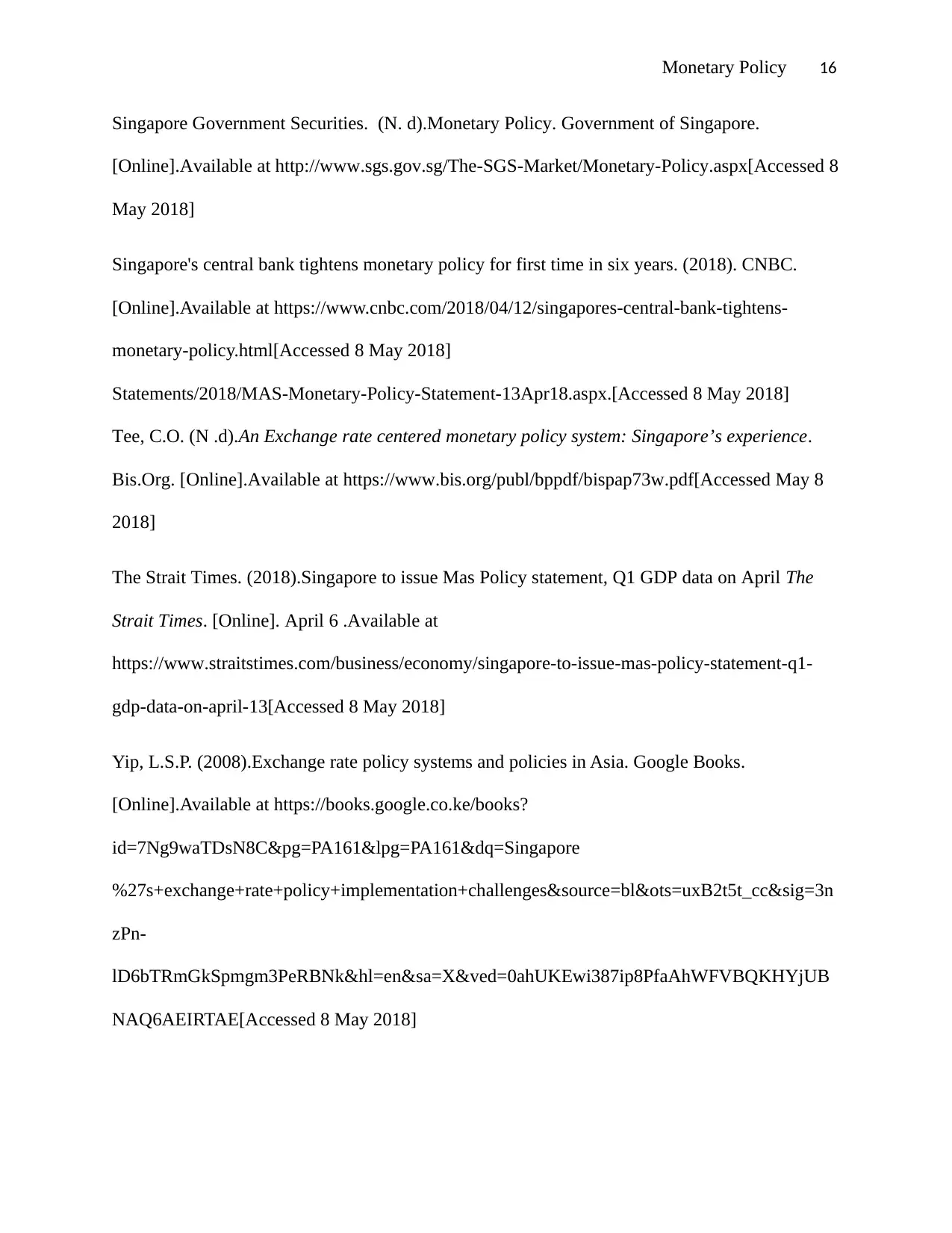
Monetary Policy 16
Singapore Government Securities. (N. d).Monetary Policy. Government of Singapore.
[Online].Available at http://www.sgs.gov.sg/The-SGS-Market/Monetary-Policy.aspx[Accessed 8
May 2018]
Singapore's central bank tightens monetary policy for first time in six years. (2018). CNBC.
[Online].Available at https://www.cnbc.com/2018/04/12/singapores-central-bank-tightens-
monetary-policy.html[Accessed 8 May 2018]
Statements/2018/MAS-Monetary-Policy-Statement-13Apr18.aspx.[Accessed 8 May 2018]
Tee, C.O. (N .d).An Exchange rate centered monetary policy system: Singapore’s experience.
Bis.Org. [Online].Available at https://www.bis.org/publ/bppdf/bispap73w.pdf[Accessed May 8
2018]
The Strait Times. (2018).Singapore to issue Mas Policy statement, Q1 GDP data on April The
Strait Times. [Online]. April 6 .Available at
https://www.straitstimes.com/business/economy/singapore-to-issue-mas-policy-statement-q1-
gdp-data-on-april-13[Accessed 8 May 2018]
Yip, L.S.P. (2008).Exchange rate policy systems and policies in Asia. Google Books.
[Online].Available at https://books.google.co.ke/books?
id=7Ng9waTDsN8C&pg=PA161&lpg=PA161&dq=Singapore
%27s+exchange+rate+policy+implementation+challenges&source=bl&ots=uxB2t5t_cc&sig=3n
zPn-
lD6bTRmGkSpmgm3PeRBNk&hl=en&sa=X&ved=0ahUKEwi387ip8PfaAhWFVBQKHYjUB
NAQ6AEIRTAE[Accessed 8 May 2018]
Singapore Government Securities. (N. d).Monetary Policy. Government of Singapore.
[Online].Available at http://www.sgs.gov.sg/The-SGS-Market/Monetary-Policy.aspx[Accessed 8
May 2018]
Singapore's central bank tightens monetary policy for first time in six years. (2018). CNBC.
[Online].Available at https://www.cnbc.com/2018/04/12/singapores-central-bank-tightens-
monetary-policy.html[Accessed 8 May 2018]
Statements/2018/MAS-Monetary-Policy-Statement-13Apr18.aspx.[Accessed 8 May 2018]
Tee, C.O. (N .d).An Exchange rate centered monetary policy system: Singapore’s experience.
Bis.Org. [Online].Available at https://www.bis.org/publ/bppdf/bispap73w.pdf[Accessed May 8
2018]
The Strait Times. (2018).Singapore to issue Mas Policy statement, Q1 GDP data on April The
Strait Times. [Online]. April 6 .Available at
https://www.straitstimes.com/business/economy/singapore-to-issue-mas-policy-statement-q1-
gdp-data-on-april-13[Accessed 8 May 2018]
Yip, L.S.P. (2008).Exchange rate policy systems and policies in Asia. Google Books.
[Online].Available at https://books.google.co.ke/books?
id=7Ng9waTDsN8C&pg=PA161&lpg=PA161&dq=Singapore
%27s+exchange+rate+policy+implementation+challenges&source=bl&ots=uxB2t5t_cc&sig=3n
zPn-
lD6bTRmGkSpmgm3PeRBNk&hl=en&sa=X&ved=0ahUKEwi387ip8PfaAhWFVBQKHYjUB
NAQ6AEIRTAE[Accessed 8 May 2018]
1 out of 16
Related Documents
Your All-in-One AI-Powered Toolkit for Academic Success.
+13062052269
info@desklib.com
Available 24*7 on WhatsApp / Email
![[object Object]](/_next/static/media/star-bottom.7253800d.svg)
Unlock your academic potential
© 2024 | Zucol Services PVT LTD | All rights reserved.





